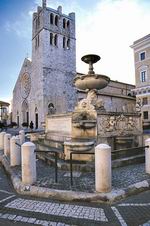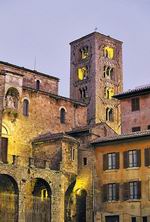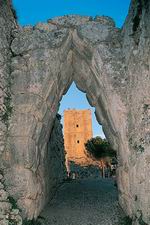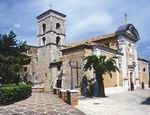| |||||
 |
Fortified towns and walls in Ciociaria | ||||
| The peculiar feature of pre-Roman Ciociaria are the towns surrounded by polygonal walls, traditionally known as the Cyclops' towns, said to have been built by the god Saturn. | |||||
| Related images (1) |
|
These lively villages are mainly perched on hilltops and their urban structures have been marked by the different civilizations (pre-Roman, Roman, medieval, Renaissance, baroque) that have left valuable traces of their culture. ALATRI
To know more about the history of this town, civilized by the Romans and the Ernici, it is advisable to visit the Civic Museum, arranged in the ancient Gottifredo Palace, where there is also the reconstruction of an Italic-Etrurian temple, unearthed within the town's territory and kept in the National Etrurian Museum of Villa Giulia in Roma. Another valuable relics, worshipped by Alatri's inhabitants, is a piece of St. Francis' mantle, kept in the church named after the poor of Assisi; it is advisable to walk along the town's slopes to reach the captivating Church of S. Silvestro (10th c.) with remains of 12th/13th-century rescoes.
ANAGNI As an ancient town, sacred for the Ernici, Anagni always played a relevant political and religious role. During the Ernici's rule, the town was completely surrounded by polygonal walls, of which only few traces are left today along the western slope of the ancient Acropolis. Dating back to the 5th and 4th century, these walls were enlarged in Roman times and encompassed the hemicycle of the Arcazzi di Piscina, which used to probably be the terracings of a thermal building dating from the end of the 3rd century and the beginning of the 2nd century B. C., and the remains of the Servian walls, whose central pillar bears a phallic symbol. Unfortunately, the walls underwent a number of remakings through the centuries. Nowadays the most striking aspect of the urban area of Anagni, the birthtown of four popes (Innocent III, Gregory IX, Alexander IV and Boniface VIII), is its medieval old town. Among the monuments, the superb Romanesque Cathedral of Santa Maria with its frescoed crypt stands out for its artistic importance; then there is the 3rd century Papal Palace, theatre of the famous “Anagni's slap”; the daring architecture of the Reason Hall in the Town Hall Palace, a supreme symbol of the civil power of Anagni's community, built between 1159 and 1163 by Iacopo da Iseo, one of the most important representatives of the Lombard towns, who came here to draft “Anagni's pacts” with Pope Adrian IV against the emperor Frederick Barbarossa. In the Church of S. Andrea, there is to be admired the Tripych of the Saviour, a splendid 12th-century wotk of Roman school. Facing the church there is the Barnekow house, an interesting example of medieval house, decorated in the 19th century with esoteric frescoes by the Swedish painter Barnekow. Many monuments are there to be discovered in this splendid town. It is advisable to walk through the alleys or along the tree-lined avenues, flanked by splendid historical buildings, such as the church of San Pietro in Vineis, a monastery existing since the 12th century. The Romanesque church still has its original cosmatesque floor and interesting 12th/14th-century frescoes.
ARPINO On top of Arpino, at Civitavecchia, there is one of the most striking monuments of pre-Roman times: a pointed arch, a Scean gate opening up in the polygonal walls, built to defend the ancient Arx, The arch is made of a series of huge blocks jointed without cement mortar. In the Middle Age, a number of towers were erected along these walls and this hamlet bacame an important strategic point for the defence of the underlying urban area of Arpino. According to an old legend, Saturn, the protector deity of agriculture, chose this place as his residence.
ATINA In the past, Atina was considered as the last bulwalk against the Samnites and thanks to the resources of its territory, full of limonite, and to the courage of its inhabitants was dubbed as 'potens' by Virgil. From the remains kept in the halls of the Civic Museum you can have an idea of the strategic importance reached by this village, surrounded by polygonal walls and lying along important commercial routes between Campania and Etruria. In the Middle Ages, too, Atina played a role as an important administration centre of the Comino Valley. Here settled the lords of Cantelmo who had made the restoration of the Duke's Palace after the violent earthquake occurred in 1349. The imposing bulk of the castle occupies most part of Piazza Saturno, whose sober facade is enlivened by fine mullioned windows and towers., On the second floor of the palace, there is a large Roman mosai with black and white tiles (2nd century), depicting four armed heroes, that comes from the remains of an ancient domus. Behind the castle there is a parish church, the parrocchiale dell'Assunta, decorated with paintings by L. Velpi narrating the stories of St. Mark Galilean, the town's patron saint.
FERENTINO Ferentino is one of the Ciociarian towns that have the greatest number of Roman monuments and epigraphs. The oldest urban centre is enterely surrounded by polygonal walls interrupted by many gates, the most ancient of which is the Porta Sanguinaria, the bloody door, as it probably was the last passage for the condemned enemies of Ferentino, in their way to execution. The terracing of the Acropolis is undoubtedly the most imposing and captivating monument of Ferentino. Here stands a Roman cryptoporticus, better-known as the prison of St. Ambrogio, the patron saint of the town and a victim of Diocletian's persecutions. The two biggest churches of the village, namely the Romanesque Cathedral of San Giovanni and the Gothic-Cistercian church of S. Maria Maggiore, stand out for their beauty. In the cathedral there are to be admired a mosaic floor of the Cosmas, a Pachal candle, a bishop's chair by Vassalletto and one of the finest medieval ciboriums, a work by Drudus de Trivio. The Church of Santa Maria Maggiore is noteworthy for the elegance of its architecture; it was buil at the beginning of the 13th century as a food grange of the nearby abbey of Casamari and its architecture has the same Gothic-Cistercian semplicity and purity. Not far from the inhabited area, on a hilltop, there is the Celestine's monastery, devoted to St. Anthony, which served for long time as the burying placer of pope Celstine V.
VEROLI In the uppermost town of Veroli at 700 m a.s.l., there is the Rock of S. Leucio, surrounded by polygonal walls, to which walls and towers added in the Middle Ages to reinforce this century-old fortress of the Ernici. During the Ernici's era, Veroli was one of the towns that led the Lega Ernica in war against Rome. It later became a faithful ally of the Urbe and for this reason was granted the honour to celebrate the same Roman feasts, as witnessed by the Fasti Verulani, a fragment of a marble calendar of the 1st-century A. D., set in the courtyard of Reali's house; it recalls the feasts of the first three months of the year, the dies nefasti, i. e. days on which business may not be conducted, the comitial and the mixed days. Its important strategic position made it impregnable for long time and here kings, emperors and popes found shelter or were kept prisoner. It is in this hamlet that rises the most ancient church of Veroli, devoted to St. Leucio (11th century); its reduced size and the semplicity of its style make it one of the treasures of this town, full of history, art and culture.
Texts and photos courtesy of A.P.T. di Frosinone | |
 |
Search other Guides |
Related arguments
| Abbeys, churches and sanctuaries in Ciociaria |
| Archaeology in Ciociaria |
| Boroughs and castles in Ciociaria |
| Caves in Ciociaria |
| Ciociaria's Spas |
| Ciociaria's typical products and cuisine |
| Folklore and crafts in Ciociaria |
| Fortified towns and walls in Ciociaria |
| Lakes and rivers in Ciociaria |
| Open-air leisure activities in Ciociaria |
| Parks and natural reserve in Ciociaria |
| Skiing in Ciociaria |

 Munch: The Scream Within
Munch: The Scream WithinOne of the year’s most eagerly awaited exhibitions to open its doors on 14 September 2024: Edvard Munch is back in Milan with a major retrospective after a 40-year absence.
 In the garden
In the gardenThe initiative, which is scheduled to run from June 26th to September 13th, 2020, is inaugurating a temporary space for art in Corso Matteotti 5, in Milan, in the very heart of the city.
 Perugia Travel Guide
Perugia Travel GuidePerugia is the chief town of Umbria. This beautiful town is sited on a hill in the middle of a verdant country. His central square is considered one of the most beautiful squares of Italy and history, traditions, art and nature make a unique ensemble in this town as in the whole




 Alatri still has some of the most imposing surrounding walls of preroman epoch and for this reason has been dubbed along the centuries as the town of “Cyclops”. The walls, which date from the 4th century B. C., surround the whole are of the Acropolis, accesible through two gateways: Porta Maggiore, surmounted by a huge monolithic architrave, and Porta Minore, which bears there phally as apotropaic symbols of fertility and protection of the ancient Ernici community. On the esplanade, once the site of pagan temples, stand today the Bishop's seat and St. Paul's Cathedral, where are kept the Host Incarnate, an Eucharistic miracle happened in 1228, and the relics of Pope Sisto I, patron saint of Alatri.
Alatri still has some of the most imposing surrounding walls of preroman epoch and for this reason has been dubbed along the centuries as the town of “Cyclops”. The walls, which date from the 4th century B. C., surround the whole are of the Acropolis, accesible through two gateways: Porta Maggiore, surmounted by a huge monolithic architrave, and Porta Minore, which bears there phally as apotropaic symbols of fertility and protection of the ancient Ernici community. On the esplanade, once the site of pagan temples, stand today the Bishop's seat and St. Paul's Cathedral, where are kept the Host Incarnate, an Eucharistic miracle happened in 1228, and the relics of Pope Sisto I, patron saint of Alatri.
 Other remains of polygonal walls are to be seen walking up towards Civita Falconara, a quarter overlooked by the castle of Ladislao Durazzo. The heart of the village is piazza Municipio, encompassed on three sides by the Boncompagni Palace, which is today the seat of the Centro Internazionale Umberto Mastroianni, a foundation named after a famous local 20th-centruy sculptor; by the Convitto Nationale Tulliano, the seat of a prestigious high school for classical studies, that every year plays host to the Certamen Ciceronianum Arpinas, a contest where participants are requested to translate and comment on a passage by Cicero; it is an Europe-wide renowned event that gathers hundreds of European high school students. A visit to the beautiful parish church of S. Michele gives the opportunity to admire the paintings of the artist Giuseppe Cesari, better-known as the Cavalier d'Arpino, as well as works by important artists of the Roman baroque culture.
Other remains of polygonal walls are to be seen walking up towards Civita Falconara, a quarter overlooked by the castle of Ladislao Durazzo. The heart of the village is piazza Municipio, encompassed on three sides by the Boncompagni Palace, which is today the seat of the Centro Internazionale Umberto Mastroianni, a foundation named after a famous local 20th-centruy sculptor; by the Convitto Nationale Tulliano, the seat of a prestigious high school for classical studies, that every year plays host to the Certamen Ciceronianum Arpinas, a contest where participants are requested to translate and comment on a passage by Cicero; it is an Europe-wide renowned event that gathers hundreds of European high school students. A visit to the beautiful parish church of S. Michele gives the opportunity to admire the paintings of the artist Giuseppe Cesari, better-known as the Cavalier d'Arpino, as well as works by important artists of the Roman baroque culture.